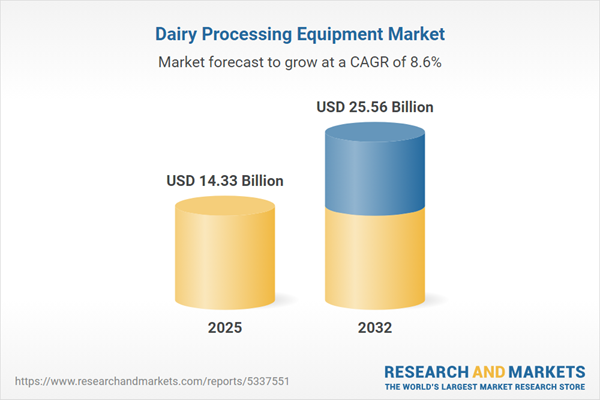Speak directly to the analyst to clarify any post sales queries you may have.
The dairy processing equipment market is rapidly evolving, with advanced technology, regulatory changes, and shifting consumer trends pushing senior executives to rethink their investment and operational strategies. Modernization is key to maintaining compliance, efficiency, and competitiveness as the global dairy sector faces increased demand for quality, sustainability, and differentiation.
Market Snapshot: Dairy Processing Equipment Market Growth and Trends
The Dairy Processing Equipment Market grew from USD 13.18 billion in 2024 to USD 14.33 billion in 2025, supported by an expected CAGR of 8.63%. The sector is forecasted to reach USD 25.56 billion by 2032, reflecting increasing adoption of automation, energy-efficient solutions, and digital monitoring tools.
Industry players prioritize innovation and operational agility to align with rising global dairy consumption and evolving regulatory environments.Scope & Segmentation: Comprehensive Market Coverage
- Equipment Types: CIP systems (mobile, stationary), evaporators (falling film, rising film, plate), fillers and packaging equipment (aseptic, gravity, piston), homogenizers (high pressure, micro, ultrasonic), pasteurizers (high temperature short time, low temperature long time, ultra high temperature), separators and clarifiers (disc stack centrifuge, nozzle clarifier), spray dryers (nozzle, rotary).
- Applications: Butter production, cheese processing (hard, processed, soft), infant formula formulation, milk handling, whey product concentration, yogurt (Greek, set, stirred).
- End Users: Large integrated dairies, medium-scale operations, small artisanal producers.
- Distribution Channels: Direct sales, distributor networks, aftermarket (refurbished equipment, spare parts).
- Regional Coverage: Americas (North America, Latin America), Europe Middle East & Africa, Asia-Pacific, with a focus on established and high-growth markets across United States, Canada, China, India, Germany, Brazil, UAE, and others.
Key Takeaways for Senior Decision-Makers
- Integration of digitalization and automation improves real-time quality control, minimizing product inconsistencies and production downtime.
- Adoption of advanced technologies such as predictive maintenance and energy recovery systems extends equipment lifecycles and contains operational costs.
- Sustainability initiatives surrounding water- and energy-efficient systems support environmental compliance and bolster brand reputation among eco-aware stakeholders.
- Strategic segmentation by application and end user enables tailored equipment solutions, ensuring flexibility from large-scale producers to niche artisanal processors.
- Strong demand for modular and easily retrofittable systems enables agile responses to shifting consumer preferences and regulatory landscapes.
- Growing collaboration between equipment manufacturers and processors drives R&D, resulting in innovative products like high-protein powders and heat-sensitive dairy ingredients.
Tariff Impact: Navigating United States 2025 Measures
New tariff measures in the United States for 2025 are reshaping sourcing and procurement strategies for processors relying on imported equipment and components. Domestic production options and supply chain diversification have become strategic priorities, while total cost of ownership calculations increasingly factor in potential import duties. Partnerships with regional OEMs and investments in service networks strengthen resilience and help maintain operational continuity amid shifting trade dynamics.
Primary Keyword Focus: Dairy Processing Equipment Market Insights
This report delivers actionable insights tailored specifically for the dairy processing equipment market. By providing a clear understanding of process integration best practices, regional drivers, and strategic technology adoption, it empowers decision-makers to steer investment with confidence.
Methodology & Data Sources
Our analysis is structured around primary data collection through executive interviews and operations manager insights, paired with secondary validation from technical journals, regulatory filings, and trade publications. Triangulation across quantitative and qualitative sources ensures reliability and depth in every recommendation.
Why This Report Matters
- Enables executives to optimize technology investments by mapping current and future market opportunities.
- Supports strategic planning with detailed segmentation across equipment types, applications, and regions.
- Identifies evolving regulatory and economic influences, minimizing risk while supporting sustainable growth.
Conclusion
The dairy processing equipment market is shaped by innovation, sustainability, and evolving trade policies. Decision-makers equipped with comprehensive insights will be best positioned to drive lasting value and resilient growth in this dynamic landscape.
Additional Product Information:
- Purchase of this report includes 1 year online access with quarterly updates.
- This report can be updated on request. Please contact our Customer Experience team using the Ask a Question widget on our website.
Table of Contents
3. Executive Summary
4. Market Overview
7. Cumulative Impact of Artificial Intelligence 2025
Companies Mentioned
The companies profiled in this Dairy Processing Equipment market report include:- Tetra Pak International S.A.
- GEA Group Aktiengesellschaft
- Alfa Laval Corporate AB
- SPX FLOW, Inc.
- JBT Corporation
- Krones Aktiengesellschaft
- KHS GmbH
- Bucher Industries AG
- IMA S.p.A.
- ANDRITZ AG
Table Information
| Report Attribute | Details |
|---|---|
| No. of Pages | 188 |
| Published | October 2025 |
| Forecast Period | 2025 - 2032 |
| Estimated Market Value ( USD | $ 14.33 Billion |
| Forecasted Market Value ( USD | $ 25.56 Billion |
| Compound Annual Growth Rate | 8.6% |
| Regions Covered | Global |
| No. of Companies Mentioned | 11 |









